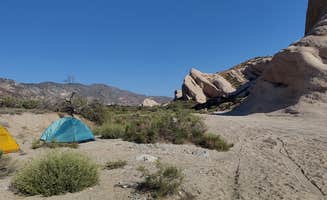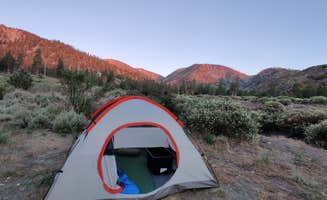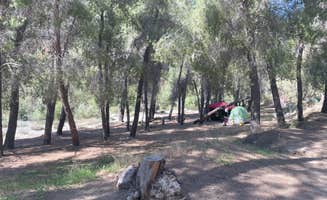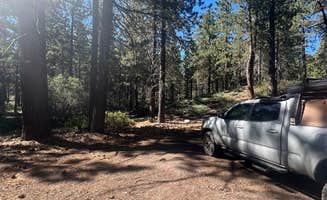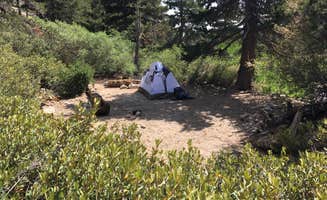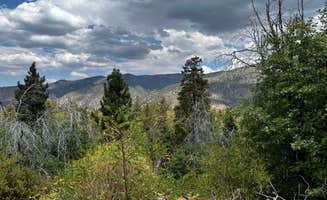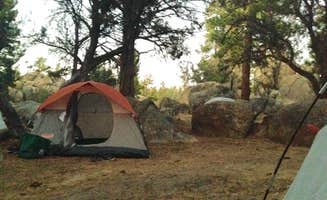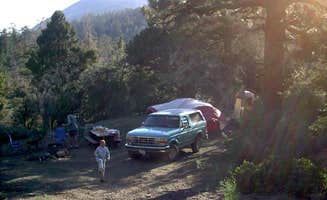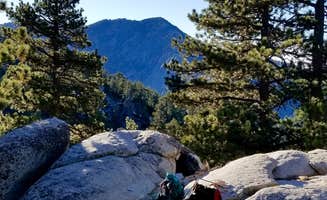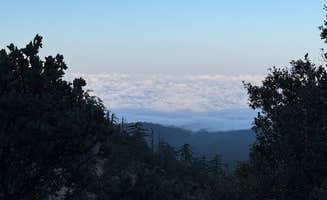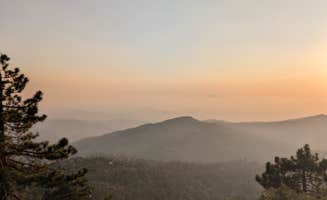Dispersed camping near Bloomington, California requires advance planning due to variable terrain conditions and seasonal restrictions in the San Bernardino National Forest. Most sites sit between 5,000 and 7,000 feet elevation, offering cooler temperatures than the valley floor during summer months. The region experiences significant seasonal variation with snow-covered access roads in winter and high fire danger periods during summer and fall that affect camping regulations.
What to do
Hiking to waterfalls: San Gorgonio Wilderness areas require permits but offer rewarding experiences near Vivian Creek Camp, where "there is a lovely creek that lead to a waterfall that some repel down." The camp provides "nice dirt flat spots within the trees, looking down at the trail."
Gold panning: Try your luck in historic gold mining areas at Holcomb Valley Climbers Camp. One visitor notes, "If you're into panning for gold you just might find some along Holcomb Creek. There are active claims in the area so be respectful." The area has historical significance as the "site of gold discovery in the 1800s."
Rock climbing: Several dispersed camping spots cater to climbers. Holcomb Valley Climbers Camp "is used almost exclusively by rock climbers, but anyone is welcomed. As long as you follow the guidelines for the area, you can set up your tent anywhere you see a spot."
What campers like
Solitude: Many campers appreciate the relative isolation at East Flats camping areas. One visitor described it as "so peaceful and the air is so fresh! Pines, and clear blue skies!" Another camper noted they "drove past a few campers. A few with big RV's. Closest camper is about 30 yards away."
Wildlife viewing: The rustic camping near Bloomington provides opportunities to observe local fauna. According to reviews, at East Flats, campers "saw multiple deer walking by our site." The remote locations throughout the San Bernardino mountains provide natural animal habitat away from developed areas.
Stargazing: The primitive camping locations offer excellent night sky viewing opportunities. One camper at Mill Creek Dispersed Camping appreciated that "there are over a dozen sites along the main road. If you can pull in, it's a site. Some better than others and spaced out so you may not see your neighbors from your site."
What you should know
Vehicle requirements: Most dispersed sites require appropriate vehicles. At Stockton Flats Yellow Post Sites, camping is "great for campers that meet 2 criteria 1) You have a Jeep, Truck it similar vehicle that can go off-road. 2) You enjoy dispersed camping (no water/restrooms etc)." One camper warned "the turn is not marked well, in fact the coordinates are a little bit off."
Navigation challenges: Access roads can be confusing and poorly marked. At Rim of the World Byway, campers advise to "use Google Maps; Waze takes you the wrong way, cause it's just right off the freeway, not down a long, very bumpy dirt road." Another camper found "there were some cars parked near the entrance, but if you go a bit further down alongside the road you can find some nice spots."
Permit requirements: Some wilderness areas require advance permits. In San Gorgonio Wilderness, "this campground is one of the most popular out of the 4 on this trail! You have to get your permit early in the summer season because of that!" Check with the local ranger station before planning your trip.
Tips for camping with families
Choose accessible sites: Some dispersed camping locations are more family-friendly than others. One family at Rim of the World Byway found "we stayed here for two nights, and it was a pretty pleasant experience! There were some cars parked near the entrance, but if you go a bit further down alongside the road you can find some nice spots."
Prepare for dirt: Primitive sites have natural surfaces that affect equipment and children. As one parent noted about Holcomb Valley, "our kids loved being able to explore, but they were covered in sand/dirt by the end of the trip."
Consider campsite spacing: Look for areas with buffer zones between sites for safety and privacy. At Mill Creek Dispersed Camping, "there are lots of sites on this road. The closer you are to the road the more dust will get in your site from the vehicles passing."
Tips from RVers
Size limitations: Large RVs face significant restrictions at most dispersed sites. One RVer examining Mill Creek Dispersed Camping found that "the road up to the actual spot is gravel, with lots of potholes and washboard areas, which would make it difficult for an RV. But the biggest issue for RVs is an area of the road that is very steep and immediately turns into a hairpin turn."
Level parking spots: Some areas accommodate larger vehicles better than others. At East Flats, an RVer reported "the campsite was easy to find there are plenty of spots and they are level multiple spots for a class a 34 foot motorhome." Another confirmed "there are a lot of spaces and larger rigs will do just fine within the first 1/4 mile."
Road condition reports: Check recent reviews for current accessibility. A recent visitor noted that at East Flats "roads are a bit rough with rock and drainage ditches but our 40' trailer had zero issues."


